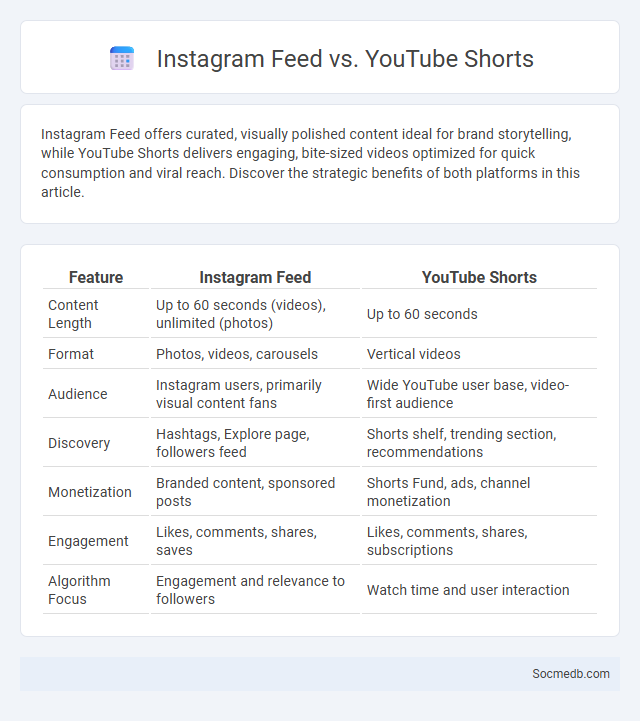
Photo illustration: Instagram Feed vs YouTube Shorts
Instagram Feed offers curated, visually polished content ideal for brand storytelling, while YouTube Shorts delivers engaging, bite-sized videos optimized for quick consumption and viral reach. Discover the strategic benefits of both platforms in this article.
Table of Comparison
| Feature | Instagram Feed | YouTube Shorts |
|---|---|---|
| Content Length | Up to 60 seconds (videos), unlimited (photos) | Up to 60 seconds |
| Format | Photos, videos, carousels | Vertical videos |
| Audience | Instagram users, primarily visual content fans | Wide YouTube user base, video-first audience |
| Discovery | Hashtags, Explore page, followers feed | Shorts shelf, trending section, recommendations |
| Monetization | Branded content, sponsored posts | Shorts Fund, ads, channel monetization |
| Engagement | Likes, comments, shares, saves | Likes, comments, shares, subscriptions |
| Algorithm Focus | Engagement and relevance to followers | Watch time and user interaction |
Introduction to Instagram Feed, YouTube Shorts, and Feed
Instagram Feed showcases a curated collection of photos and videos, optimized for engaging audiences with visually appealing content and strategic use of hashtags to increase discoverability. YouTube Shorts offers brief, vertical videos up to 60 seconds, leveraging algorithm-driven recommendations to boost rapid viewer engagement and growth. Both platforms prioritize consistent content updates to maintain follower interaction and enhance online presence.
Key Features Comparison of Instagram Feed and YouTube Shorts
Instagram Feed offers visually curated photos and videos with permanent post visibility, allowing detailed captions, hashtags, and user interactions through likes, comments, and shares, designed for storytelling and brand building. YouTube Shorts features vertical, short-form videos up to 60 seconds, optimized for quick consumption and viral reach, with tools like music overlays, speed controls, and easy discovery via the Shorts shelf. Both platforms emphasize user engagement but differ in content length, format, and discovery algorithms tailored to distinct audience behaviors.
Content Format Differences: Instagram Feed vs YouTube Shorts
Instagram Feed emphasizes visually appealing, high-quality images and short videos optimized for square or portrait formats, focusing on aesthetic consistency and brand storytelling. YouTube Shorts prioritizes vertical, short-form videos under 60 seconds, designed for quick engagement and viral trends with dynamic editing features. Your content strategy should adapt to these format differences to maximize reach and audience engagement on each platform.
Audience Engagement Levels on Each Platform
Audience engagement levels vary significantly across social media platforms, with Instagram and TikTok leading due to their emphasis on visual content and short, interactive videos that drive higher interaction rates. Facebook maintains strong engagement through diverse content formats like live videos, groups, and targeted ads, enhancing community participation and user retention. Twitter offers real-time interaction, making it ideal for timely updates and discussions, though its engagement rates generally trail behind more visually-driven platforms.
Algorithm Insights: How Instagram Feed and YouTube Shorts Work
Instagram Feed uses a personalized ranking algorithm that prioritizes content based on user interactions, recency, and relationship strength. YouTube Shorts leverages a content discovery model driven by watch time, user engagement, and relevance to trending topics, ensuring rapid visibility for popular clips. Both platforms continuously analyze behavioral data to optimize content delivery and enhance user experience.
Content Creation Strategies for Maximum Reach
Content creation strategies for maximum reach prioritize understanding target audience behavior and platform algorithms to tailor engaging, shareable posts. Utilizing visually compelling media, consistent posting schedules, and interactive elements such as polls or live videos significantly amplifies audience engagement. Leveraging trending topics, hashtag optimization, and cross-platform promotion ensures content visibility and attracts diverse followers.
Branding Opportunities Across Instagram and YouTube
Instagram and YouTube offer powerful branding opportunities by enabling businesses to create visually engaging content that resonates with diverse audiences. You can leverage Instagram's Stories, Reels, and IGTV to showcase your brand personality and build community engagement, while YouTube provides a platform for in-depth tutorials, testimonials, and product demonstrations that enhance brand credibility. Both platforms' algorithms prioritize authentic interaction, boosting your visibility and fostering long-term customer loyalty.
Pros and Cons: Instagram Feed vs YouTube Shorts
Instagram Feed offers a curated, high-quality visual experience ideal for brand storytelling and engagement through photos and videos up to 60 seconds, maximizing aesthetic appeal and user interaction. YouTube Shorts provides rapid, bite-sized video content under 60 seconds designed for virality and quick consumption, leveraging YouTube's massive user base and algorithm-driven discovery. However, Instagram Feed may face limitations in video length and discovery compared to YouTube Shorts, which can struggle with deeper audience retention and content depth.
Monetization Potential: Which Platform Wins?
YouTube leads in monetization potential with its robust ad revenue sharing and diverse income streams such as Super Chats, memberships, and merchandise shelf. Instagram offers significant earning opportunities through sponsored posts, affiliate marketing, and IG Shopping, yet generally requires a strong follower base to maximize profits. TikTok's Creator Fund and brand partnerships present emerging revenue paths, but monetization options remain less developed compared to YouTube and Instagram.
Choosing the Right Platform for Your Social Media Goals
Choosing the right social media platform is essential to align with your specific marketing goals and target audience demographics. Platforms like Instagram excel in visual storytelling, while LinkedIn is ideal for B2B networking and professional branding. Understanding your audience's preferences guides you to optimize content strategy and maximize engagement effectively on the most suitable channels.
 socmedb.com
socmedb.com